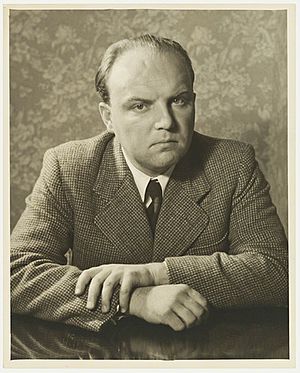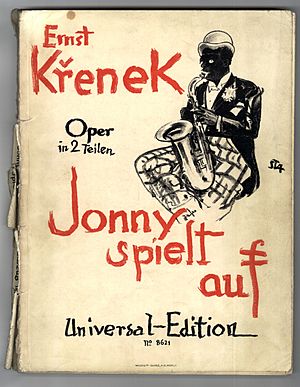Ernst Krenek facts for kids
Quick facts for kids
Ernst Krenek
|
|
|---|---|

Ernst Krenek in 1937
|
|
| Born |
Ernst Heinrich Křenek
23 August 1900 Vienna, Austria-Hungary
|
| Died | 22 December 1991 (aged 91) Palm Springs, California, U.S.
|
Ernst Heinrich Krenek (born August 23, 1900 – died December 22, 1991) was a famous composer. He was born in Austria and later became an American citizen. His family was originally from Czechia.
Krenek explored many different modern music styles. He wrote several books about music. These included Music Here and Now (1939) and Horizons Circled: Reflections on my Music (1974). He also wrote two musical pieces using the fake name Thornton Winsloe.
Contents
Life of Ernst Krenek
Ernst Heinrich Křenek was born in Vienna, which was then part of Austria-Hungary. His father was a Czech soldier. Ernst studied music in Vienna and Berlin. His teacher was Franz Schreker. After his studies, Krenek worked as a conductor in German opera houses.
During World War I, Krenek joined the Austrian army. But he stayed in Vienna, so he could continue his music studies. In 1922, he met Alma Mahler, who was the wife of the famous composer Gustav Mahler. He also met her daughter, Anna Mahler. Krenek dedicated his Symphony No. 2 to Anna. He married her in January 1924, but they divorced less than a year later.
Around the time he married Anna Mahler, Krenek was finishing his Violin Concerto No. 1. An Australian violinist named Alma Moodie helped him. She did not help with the music itself. Instead, she helped him get money from her friend Werner Reinhart. This was important because money was losing its value very quickly in Germany at that time. Krenek was thankful and dedicated the concerto to Moodie. She performed it for the first time on January 5, 1925.
Krenek's opera Jonny spielt auf was completed in 1926. It was a huge success all over Europe. This opera made Krenek very famous for several years. There is even a brand of cigarettes in Austria named "Jonny" to this day. However, Krenek became uncomfortable with this fame. Other musicians thought his music was becoming too commercial. So, he soon changed his musical style completely.
Jonny spielt auf used jazz music. It also featured a Black jazz musician as a main character. This character was shown having relationships and stealing a valuable violin. Because of this, the rising Nazi Party did not like Krenek's opera. The image of Jonny was even used on a poster for an exhibition called Entartete Musik (Degenerate Music) in 1938. This exhibition showed music that the Nazis did not approve of.
The Nazis often said Krenek was a Jewish composer, even though he was not. They tried to stop his music from being performed. For example, in 1933, his music for a play was removed in Mannheim. The Vienna State Opera also canceled a new opera he was writing called Karl V.
In 1938, Krenek moved to the United States. He taught music at different universities. He taught at Vassar College and later at Hamline University in Saint Paul, Minnesota. While at Hamline, he met and married his third wife, Gladys Nordenstrom. She was one of his students. He became an American citizen in 1945.
Later, he moved to Toronto, Ontario, Canada. He taught at The Royal Conservatory of Music in the 1950s. Many students learned from him, including Milton Barnes and George Perle. He then moved to Tujunga and later to Palm Springs, California in 1966. Krenek passed away there in 1991 at the age of 91. He was buried in Vienna, Austria. In 1998, Gladys Nordenstrom started the Ernst Krenek Institute to honor him.
Completing Other Composers' Music
After meeting Krenek in 1922, Alma Mahler asked him to finish her late husband's Symphony No. 10. Krenek helped edit parts of it but did not complete the whole work.
Krenek also helped his friend Eduard Erdmann. Erdmann was a pianist and composer. He wanted to play Franz Schubert's unfinished Reliquie piano sonata. Krenek helped complete the missing third and fourth movements of this piece.
Completing another composer's unfinished work is very difficult. Krenek believed it should only be done if the original piece already has all the main ideas. If so, a skilled musician can try to finish it in the way the original composer might have. They would study the composer's style very carefully.
However, Krenek knew that even great artists sometimes do unexpected things. He said that if a painting is missing just a small part, someone might be able to finish it. But if two whole paintings are missing from a set of four, no one could truly create them. They would just be "fakes."
He used Schubert's "Unfinished" Symphony as an example. It only has two movements, and there are no clues for the other two. Krenek said that someone could write two more movements in Schubert's style, but they would not truly be Schubert's.
Ernst Krenek's Musical Style
Krenek's music changed a lot over his life. It showed many of the main musical ideas of the 20th century.
His early music sounded like late-Romantic style. This showed the influence of his teacher, Franz Schreker. But around 1920, he started using atonality. This means music without a clear key or center.
After visiting Paris, he heard music by Igor Stravinsky and Les Six. This led him to a neo-classical style around 1924. This style looked back to older, clearer forms of music. Soon after, he moved to neoromanticism. He also added jazz influences to his opera Jonny spielt auf (1926). Other neoromantic works were inspired by Franz Schubert. An example is Reisebuch aus den österreichischen Alpen (1929).
In the late 1920s, Krenek stopped using the neoromantic style. He began to use Arnold Schoenberg's twelve-tone technique. This is a way of composing where all 12 notes of the musical scale are used equally. He used this method in his opera Karl V (1931–33) and most of his later pieces.
In 1955, he worked in an Electronic Music Studio in Cologne. This experience made him explore serial music. This is a very organized way of composing. Around 1960, he also started using aleatoric music. This means music where some parts are left to chance. Examples include Horizon Circled (1967).
In his later years, his music became more relaxed. But he still used elements of both twelve-tone and serial techniques.
Works
Awards and Honors
- 1951: Order of Merit of the Federal Republic of Germany
- 1955: City of Vienna Prize for Music
- 1960: Grand Decoration of Honour in Silver (a high Austrian award)
- 1960: Gold Medal of the City of Vienna
- 1963: Grand Austrian State Prize for Music
- 1965: Commander's Cross of the Order of Merit of the Federal Republic of Germany
- 1966: Bach Prize of the Free and Hanseatic City of Hamburg
- 1970: Honorary Ring of the Vienna
- 1975: Austrian Decoration for Science and Art
- 1978: Goethe Medal of Hesse
- 1980: Honorary Citizen of the City of Vienna
- 1984: Honorary Citizen of the City of New Orleans
- 1990: Grand Decoration of Salzburg
On Krenek's 85th birthday, the City of Vienna created the Ernst Krenek Prize.
Honorary Degrees
- 1944: Hamline University, St. Paul
- 1953: Chapman College, Los Angeles
- 1965: University of New Mexico, Albuquerque
- 1976: New England Conservatory, Boston
- 1977: Philadelphia Musical Academy, Philadelphia
See also
 In Spanish: Ernst Krenek para niños
In Spanish: Ernst Krenek para niños


